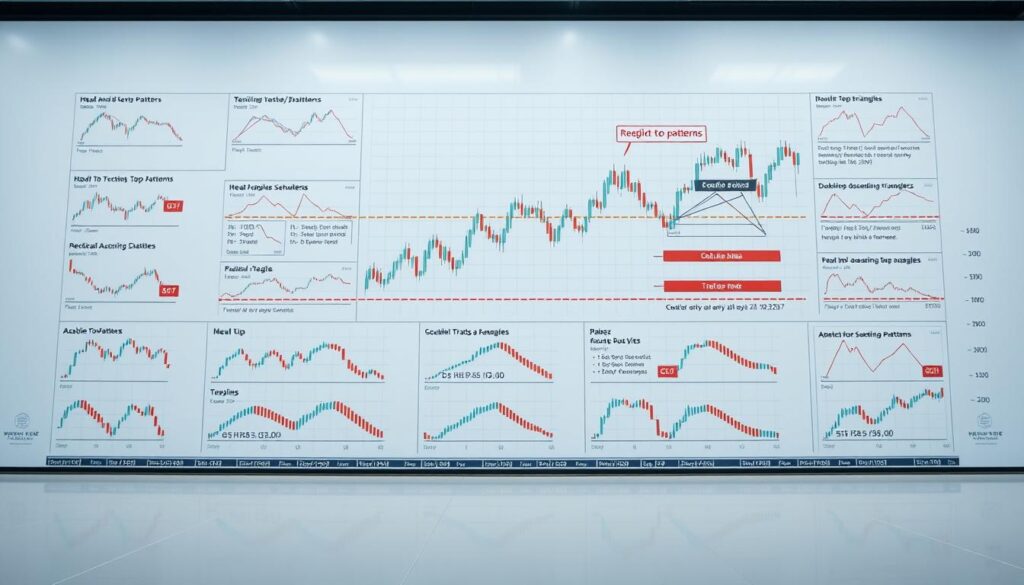What is break of structure in trading? This term refers to a price movement that breaks through key support or resistance levels, signaling a potential shift in market trends. The definition break of structure in trading centers on these pivotal moments where prior patterns are disrupted, offering clues about upcoming volatility or reversals. Traders rely on this concept to spot high-probability setups across stocks, forex, and other markets.
Whether you’re a beginner or an experienced investor, recognizing these breaks helps align trades with market momentum. It’s not just about numbers—it’s about reading the story prices tell through their highs and lows. This insight turns uncertainty into actionable strategies, making it a must-learn for anyone serious about technical analysis.
Key Takeaways
- A break of structure marks a price move beyond critical support/resistance levels.
- It’s a core part of technical analysis for spotting trend reversals or continuations.
- Traders use it to time entries/exits during high-impact market shifts.
- Applicable to all markets, from equities to digital currencies.
- Reduces guesswork by focusing on proven price patterns and confirmed levels.
Understanding the Basic Concepts of Break of Structure
Mastering trading starts with grasping foundational ideas. This section explores core principles tied to definition break of structure in trading and why traders prioritize these concepts daily.
Defining Market Structure
Market structure refers to the natural patterns formed by price movements over time. Traders track definition break of structure in trading by analyzing swing highs and lows. These points form support/resistance levels that guide decision-making.
Importance of Structure in Trading
“Structure is the skeleton of the market.” – John Carter, Professional Trader
Traders rely on structure to spot trends and predict shifts. The importance break of structure in trading lies in its role as an early warning system for trend reversals. Without understanding structure, traders risk missing critical turning points.
How Breaks Indicate Potential Changes
A break occurs when price moves beyond a prior swing high/low. Key signs include:
- Sharp price movement beyond a defined level
- Increased trading volume during the breakout
- Immediate price rejection or acceptance at the new level
Below summarizes core contrasts:
| Market Structure | Break of Structure |
|---|---|
| Consistent swing highs/lows | Price exceeding prior extremes |
| Traders focus on consolidation | Signals new trend potential |
Types of Breaks in Market Structure
Mastering trading break of structure starts with recognizing the three main types of market shifts. Each type signals unique opportunities but demands distinct strategies. Here’s how to spot them in real-time:
Breakouts
- Occurs when price surpasses resistance levels, signaling sustained upward momentum
- Example: Nasdaq breaking 15,000 in 2023 after prolonged consolidation
- Traders often enter analyzing break of structure using moving averages for confirmation
Breakdowns
- Occurs when support levels collapse, triggering bearish trends
- Example: Crude oil跌破$60 support in 2024
- Volume spikes during breakdowns validate significance
Reversals
- Structural shift reversing prior trends (e.g., multi-month downtrends ending abruptly)
- Identified through price pattern failures like failed head-and-shoulders formations
- Bitcoin’s 2020 $6,000 reversal marked a major structural shift
| Type | Direction | Key Signal | Example |
|---|---|---|---|
| Breakout | Uptrend | Resistance penetration | Apple stock surpassing $200 |
| Breakdown | Downtrend | Support collapse | Gold跌破$1,600 |
| Reversal | Directional shift | Pattern failure | SP500 2023 low reversal |
Recognizing these patterns helps traders align strategies with market behavior. Pairing analyzing break of structure with volume analysis maximizes accuracy. Keep this guide handy when studying charts for actionable signals.
How to Identify a Break of Structure
Mastering identifying break of structure starts with practical tools. Let’s explore proven methods traders use to spot these critical moments in real time.

Technical Indicators to Use
Pair technical tools with price action for clarity:
| Indicator | Use Case | Signal |
|---|---|---|
| MACD | Confirm trend shifts | Crossover above/below zero line |
| RSI | Spot overbought/oversold extremes | Breaks above 70 or below 30 |
| 50-day MA | Track long-term trends | Price crossing the moving average |
Price Action Analysis
Watch for these visual clues on charts:
- Engulfing candles overtaking prior session ranges
- Pin bars forming at key resistance/support levels
- Three-method formations signaling momentum shifts
Volume Analysis
Volume validates or invalidates breaks. High volume during a breakout suggests real momentum. Sudden spikes often confirm structural changes. Low volume breaks are often false moves.
Practice spotting these patterns on historical charts. Start with daily charts and gradually apply techniques to intraday setups. Remember, consistency in analysis builds confidence.
Common Mistakes Traders Make
Even experienced traders can stumble over trading break of structure pitfalls. Here’s how to avoid three key errors that derail many strategies:
Ignoring Confirmations
- Jumping into trades without verifying signals
- Failure to wait for volume spikes or indicator alignment
- Risking capital on unconfirmed trading break of structure setups
Misinterpreting Breaks
A break of structure isn’t always a valid signal. Traders often:
“False breaks waste time and capital. Always double-check with price action and momentum indicators.”
Confuse noise with real trends by:
- Overlooking retracement patterns
- Ignoring higher timeframe context
Overtrading After a Break
| Mistake | Solution |
|---|---|
| Chasing trends after initial moves | Use stop-losses and wait for pullbacks |
| Adding positions without reevaluation | Confirm continuation with analyzing break of structure using RSI/divergence checks |
Mindfulness and patience turn these lessons into strengths. Reviewing setups with confirmation tools prevents costly errors in trading break of structure scenarios.
The Role of Support and Resistance
Support and resistance levels act as the foundation for spotting critical market turning points. Traders using break of structure trading strategy rely on these levels to predict price movements. But not all lines are equal—only those with repeated price rejection hold real significance.
Identifying Key Levels
Start by scanning charts for areas where prices paused or reversed. Identifying break of structure requires looking for zones where buyers or sellers dominated historically. Look for clusters of prior highs/lows, round numbers, or gaps. These form the backbone of reliable support/resistance.
How Breaks Affect Support and Resistance
- A breakout above resistance converts that level into new support
- Breaks below support flip it into resistance
- Volume spikes confirm valid structure changes
Trading Strategies Around Key Levels
After a confirmed break, position entries can target retracements to former levels. For example:
1. Enter long after price closes above resistance
2. Set stops below recent swing lows
3. Target prior support turned resistance zones
Combine these with trend indicators like moving averages for stronger signals. Always pair entries with risk management—never guess, always verify.
Analyzing Chart Patterns
Chart patterns are visual roadmaps that traders use to predict break of structure pattern moments. By analyzing break of structure through these shapes, traders spot opportunities before the crowd. Let’s explore how patterns like head and shoulders or triangles act as early warning signs.

Common Patterns That Indicate Breaks
Key patterns to watch:
- Head and Shoulders: A reversal signal after an uptrend
- Double Tops/Bottoms: Confirm resistance/support breakdowns
- Symmetrical Triangles: Indicate pending volatility spikes
- Flags and Pennants: Signal continuation after price surges
How Patterns Support Break Structure
These formations reflect crowd behavior. For example, a break of structure pattern like a head and shoulders shows weakening buying pressure. Traders combine these visuals with volume and trend lines to confirm validity. As analyst Mark Minnes notes,
“Patterns are human psychology frozen in price action.”
Examples of Effective Patterns
| Pattern | Market Event | Outcome |
|---|---|---|
| Head and Shoulders | Bitcoin 2021 peak | 60% drop followed neckline breakdown |
| Symmetrical Triangle | 2023 Nasdaq rally | 20% price surge after breakout |
Mastering these patterns turns charts into predictive tools. Start spotting them on daily charts and track their accuracy over time.
The Importance of Timeframes
Timeframes shape how traders interpret breaks in market structure. What is break of structure in trading depends on the timeframe you analyze. A 1-minute chart’s spike might fade on a weekly view, showing why timeframe choice matters.
How Different Timeframes Affect Breaks
Short-term frames (like 1-hour charts) react to noise, while long-term frames (daily/weekly) highlight trends. A break on a 5-minute chart could be a false signal if ignored in context. Use this to:
- Filter volatility spikes
- Confirm trends across scales
- Balance urgency and patience
Short-Term vs. Long-Term Breaks
Short-term breaks offer quick entry but risk whipsaws. Long-term breaks confirm durable shifts but delay opportunities. Compare them like:
- Short-term: Fast profits, high risk
- Long-term: Steadier trends, slower gains
Choosing the Right Timeframe
Align your strategy with your goals. Ask:
“Does your lifestyle match a 5-minute chart’s demands?”
Pick a timeframe based on:
- Trading goals (scalping vs. position trading)
- Available analysis time
- Risk tolerance
The importance break of structure in trading lies in adapting to timeframe dynamics. Mix multiple frames to avoid blind spots. Test setups across 4-hour and daily charts before acting. Adapt, don’t rigidly stick to one view.
Confirming Breaks with Volume
Volume is the silent partner in identifying break of structure. Traders often overlook its role, but it confirms whether a price move has real momentum. This section breaks down how to use volume to strengthen your analysis.
Understanding Volume Trends
Start by tracking analyzing break of structure through daily volume patterns. Key trends include:
- Rising volume during upward price trends
- Declining volume in stagnant markets
- Sudden spikes signaling institutional activity
The Relationship Between Volume and Breaks
A valid break needs volume to match price action. High volume on a breakout confirms trader participation. Low volume suggests doubt. For example:
A clean break with 50% higher volume than the prior week’s average is a strong signal.
Using Volume to Validate Trading Decisions
Follow these steps to validate breaks:
- Compare current volume to 20-day average
- Check if volume spikes align with price moves
- Reject breaks with volume below 80% of the average
Pair volume analysis with price charts for clarity. Tools like On-Balance Volume (OBV) highlight trends over time. Always cross-verify—volume alone isn’t enough, but it’s a critical layer in confirming analyzing break of structure.
Developing a Trading Strategy around Breaks
Building a solid break of structure trading strategy requires careful planning. Start by defining clear rules for entries and exits. Consider price action, volume, and timeframe alignment to create a roadmap tailored to your goals.
Entry and Exit Rules
- Set entry triggers like confirmed price moves beyond key levels.
- Use trailing stops or profit targets for exits based on volatility.
- Test timeframes to balance short-term signals with long-term trends.
Risk Management Framework
Protect capital by limiting risk to 1-2% per trade. Place stop-loss orders below critical support or resistance zones. For example, during a trading break of structure, adjust stops dynamically as trends evolve. Always prioritize emotional discipline—stay focused even when markets swing. Learn from pros by reading proven strategies for staying calm under.
Backtesting Process
- Review historical charts to identify past structure breaks.
- Track win/loss ratios, risk-reward ratios, and consistency over time.
- Adjust rules if 60-70% of trades meet profitability benchmarks.
Customize your approach by blending these elements into a repeatable system. Remember: no single strategy fits every trader. Experiment, refine, and stay adaptable to market shifts.
Case Studies: Break of Structure in Real Markets
Real-world examples make abstract concepts tangible. Here’s how break of structure patterns and strategies appear in actual market movements.
Spotting Breaks in Major Market Shifts
In early 2020, crude oil prices collapsed below a 10-year support level, forming a historic breakdown pattern. Traders who recognized this shift adjusted strategies, capitalizing on the trend reversal. Similarly, the 2020 GameStop stock surge showed how sustained volume confirmed a breakout above resistance, a classic structure break signal.
Proven Strategies from Top Traders
Legendary traders like Mark Minervini emphasize combining structure breaks with momentum indicators. Their strategies prioritize validation: waiting for high volume during a breakout ensures reliability. For instance, during the 2022 EUR/USD downtrend, traders using this approach avoided false signals by focusing on confirmed structure breaks.
Adapting Lessons to Modern Markets
Today’s traders can apply these lessons by tracking key levels on weekly charts. A 2023 case in gold futures showed how a failed breakout at $2,000 triggered a reversal—highlighting the need for patience. Pairing this with risk management tools ensures strategies stay aligned with structure patterns, not guesswork.
Whether analyzing stocks, forex, or commodities, these examples prove that structure breaks are consistent across markets. By studying past events and adapting strategies like those shared here, traders gain clarity in uncertain conditions. The key is staying disciplined and letting the market’s structure guide decisions.

